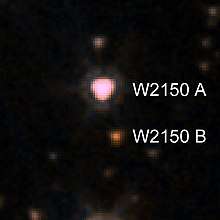W2150AB
WISE 2150-7520 AB (W2150AB) is a binary brown dwarf 78.9 light-years distant from Earth in the southern constellation Octans. The system is a wide binary with a separation of 341 astronomical units. The primary of the system was discovered in 2005 as an infrared object with high proper motion[3] and in 2008 the primary was discovered to be an ultracool dwarf with a spectral type of L.[4] The secondary in the system was discovered by volunteers of the citizen science project Backyard Worlds: Planet 9, using data from the Wide-field Infrared Survey Explorer (WISE). The system was followed up by the project scientists with Magellan and Spitzer and a scientific paper describing the binary was published in the Astrophysical Journal in 2020.[2][5]
 Artist's impression of WISE2150AB. The colder secondary WISE2150B is seen in front of the image over the Milky Way. The primary W2150A is seen as a bright star to the right of W2150B. Credit: SpaceEngine PRO, Kvasyrr | |
| Observation data Epoch J2000.0 Equinox J2000.0 | |
|---|---|
| Constellation | Octans |
| W2150 A | |
| Right ascension | 21h 50m 15.77173s[1] |
| Declination | −75° 20′ 36.7277″[1] |
| Apparent magnitude (V) | |
| W2150 B | |
| Right ascension | 21h 50m 18.99792s[2] |
| Declination | –75° 20′ 54.5964″[2] |
| Apparent magnitude (V) | |
| Characteristics | |
| Spectral type | L1+T8[2] |
| Astrometry | |
| Proper motion (μ) | RA: 888.627 ± 0.502[1] mas/yr Dec.: -298.234 ± 0.518[1] mas/yr |
| Parallax (π) | 41.3593 ± 0.2799[1] mas |
| Distance | 78.9 ± 0.5 ly (24.2 ± 0.2 pc) |
| Details | |
| W2150 A | |
| Mass | 72 ± 12[2] MJup |
| Radius | 1.03 ± 0.06[2] RJup |
| Luminosity | -3.69 ± 0.01[2] L☉ |
| Surface gravity (log g) | 5.2 ± 0.2[2] cgs |
| Temperature | 2118 ± 62[2] K |
| Age | 0.5 - 10[2] Gyr |
| W2150 B | |
| Mass | 34 ± 22[2] MJup |
| Radius | 0.95 ± 0.16[2] RJup |
| Luminosity | -5.64 ± 0.02[2] L☉ |
| Surface gravity (log g) | 4.9 ± 0.5[2] cgs |
| Temperature | 719 ± 61[2] K |
| Age | 0.5 - 10[2] Gyr |
| Position (relative to A) | |
| Component | B |
| Angular distance | 14.1″ [2] |
| Observed separation (projected) | 341 AU [2] |
| Other designations | |
| Database references | |
| SIMBAD | AB |
The system belongs to a only few brown dwarf binaries that can be easily resolved by ground-based telescopes. Another example is SDSS J1416+1348.[2]
Brown dwarf system

The system consists out of a L1 primary with a mass of 72±12 MJ and a T8 secondary with a mass of 34±22 MJ. The brown dwarfs are separated by 341 astronomical units. Other brown dwarfs show a similar wide binary configuration, like Oph 162225-240515, but most of them are young or have a higher total mass. W2150AB is unusual as it does not show signs of youth. The age of the system was estimated between 0.5 and 10 billion years. The combination of low total mass and large separation results in a low gravitational binding energy for the system. The researchers compared the binding energy and the mass ratio of the system with other brown dwarf binaries and found 2M1101AB as a younger sibling. W2150AB must have formed like other brown dwarf binaries in a more crowded region and left this natal region surviving any interactions with nearby stars or giant molecular clouds that could easily perturb this pair, leaving only two single brown dwarfs.[2][5]
See also
- LSPM J0207+3331 another object discovered by a Backyard Worlds volunteer
- UScoCTIO 108
- Luhman 16
References
- Gaia Collaboration (2018-08-01). "Gaia Data Release 2 - Summary of the contents and survey properties". Astronomy & Astrophysics. 616: A1. arXiv:1804.09365. doi:10.1051/0004-6361/201833051. ISSN 0004-6361.
- Faherty, Jacqueline K.; Goodman, Sam; Caselden, Dan; Colin, Guillaume; Kuchner, Marc J.; Meisner, Aaron M.; Gagné, Jonathan; Schneider, Adam C.; Gonzales, Eileen C.; Bardalez Gagliuffi, Daniella C.; Logsdon, Sarah E.; Allers, Katelyn; Burgasser, Adam J.; The Backyard Worlds Planet 9 Collaboration (February 2020). "WISE 2150-7520AB: A Very Low-mass, Wide Comoving Brown Dwarf System Discovered through the Citizen Science Project Backyard Worlds: Planet 9". Astrophysical Journal. 889 (2): 176. arXiv:1911.04600. Bibcode:2020ApJ...889..176F. doi:10.3847/1538-4357/ab5303. ISSN 0004-637X.
- Deacon, N. R.; Hambly, N. C.; Cooke, J. A. (May 2005). "Southern infrared proper motion survey. I. Discovery of new high proper motion stars from first full hemisphere scan". A&A. 435 (1): 363–372. Bibcode:2005A&A...435..363D. doi:10.1051/0004-6361:20042002. ISSN 0004-6361.
- Reid, I. Neill; Cruz, Kelle L.; Kirkpatrick, J. Davy; Allen, Peter R.; Mungall, F.; Liebert, James; Lowrance, Patrick; Sweet, Anne (September 2008). "Meeting the Cool Neighbors. X. Ultracool Dwarfs from the 2MASS All-Sky Data Release". AJ. 136 (3): 1290–1311. arXiv:0806.3413. Bibcode:2008AJ....136.1290R. doi:10.1088/0004-6256/136/3/1290. ISSN 0004-6256.
- "Two Co-Moving Brown Dwarfs Spotted 79 Light-Years Away | Astronomy | Sci-News.com". Breaking Science News | Sci-News.com. Retrieved 2020-02-11.
External links
- W2150AB in wiseview tool created by Backyard Worlds volunteers
- W2150B in The Extrasolar Planets Encyclopaedia